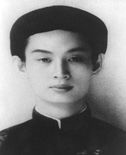PHẬT GIÁO HÒA HẢO
HARMONY BUDDHISM
Ngũ Hành
Lý thuyết Ngũ Hành học là cách cơ bản để người Trung Quốc cổ đại tìm hiểu về thế giới.
Được sử dụng rộng rãi trong y học Cổ truyền Trung Quốc, tướng thuật và bói toán. Nguồn gốc của ngũ hành là thờ phượng tổ tiên của "tất cả mọi thứ có linh hồn", khái niệm vật tổ (totem) và thờ cúng tổ tiên trong thời cổ đại.
Ngũ Hành trong tư duy của Khổng Tử được tìm thấy trong "Lễ vận", trong đó ghi lại cách Khổng Tử truyền thụ lễ vật cho Tử Du. Ý nghĩa của năm dòng bao gồm năm động lực cơ bản của quá trình tiến hóa âm dương: vàng (đại diện cho hội tụ), gỗ (đại diện cho sự tăng trưởng), nước (đại diện cho ngâm), lửa (đại diện cho sự vỡ mộng), đất (đại diện cho hội nhập).
Triết học Trung Quốc cổ đại sử dụng lý thuyết năm dòng để minh họa sự hình thành và mối quan hệ của tất cả mọi thứ trên thế giới. Nó nhấn mạnh toàn bộ, được thiết kế để mô tả các hình thức chuyển động của sự vật và các mối quan hệ chuyển đổ Âm dương là học thuyết thống nhất đối lập cổ xưa, ngũ hành là lý thuyết hệ thống nguyên thủy.
Nguồn: Baike.baidu.com
Tham khảo: Chú Giải Sám Giảng Thi Văn Giáo Ly - Thiện Tâm
Five Elements
The five-element thesis is the basic way for the ancient Chinese to know the world.
Widely used in traditional Chinese medicine, public opinion, the theorem, art, horoscope, accounting and so on. The source of the five elements is the ancient times, "all things have spirit", the totem concept and ancestral worship. Confucius's five element thought are found in the book "The Ritual", which records Confucius teaching the children the way of the operation of etiquette.
The meaning of the five elements includes five basic dynamics of yin and yang evolution: gold (for amassing), wood (for growth), water (for immersion), fire (for disillusionment), and soil (for fusion).
The ancient Chinese philosophy used five element theory to explain the formation of all things in the world and its relationship with each other. It emphasizes the whole, designed to describe the moving form of things and the transformational relationship.
Yin and Yang are the ancient theory of opposing unity, and the five elenebts are the original systematic theory.
Baike.baidu.com
Literal translation
Similar words: Five Phases
Reference: https://en.wikipedia.org/wiki/Wuxing_(Chinese_philosophy)

